Fuzhou
| Fuzhou 福州 Hók-ciŭ |
|
| — Prefecture-level city — | |
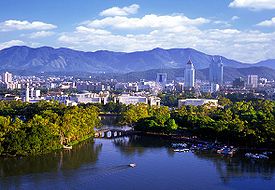 |
|
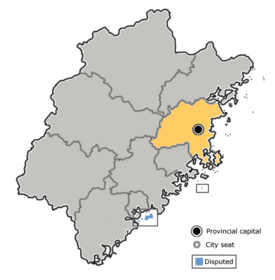 |
|
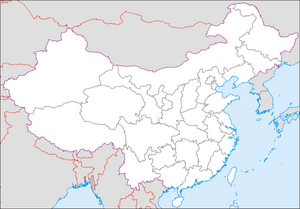 Fuzhou
|
|
| Coordinates: | |
| Country | China |
|---|---|
| Province | Fujian |
| County-level divisions | 13 |
| Area | |
| - Total | 12,000 km² (4,633.2 sq mi) |
| Population | |
| - Total | 6,608,000 |
| - Density | 550.7/km² (1,426.2/sq mi) |
| Time zone | China Standard Time (UTC+8) |
| Postal code | 350000 |
| Area code(s) | 591 |
| License plate prefixes | 闽A |
| GDP (2007) | CNY 197.5 billion |
| - per capita | CNY 29,318 |
| Website: www.fuzhou.gov.cn (Chinese) | |
Fuzhou (Chinese: 福州; pinyin: Fúzhōu; Wade-Giles: Fu-chou; Foochow Romanized: Hók-ciŭ; EFEO: Fou-Tcheou; also seen as Foochow, Fuchow, Fuh-chau or Hokchew in earlier Western documents) is the capital and the largest prefecture-level city of Fujian (福建) province, People's Republic of China. It is also referred to as Rongcheng (榕城) which means "city of banyan trees."
It is the capital of the province, and is situated on the north bank of the estuary of Fujian's largest river, the Min River, which gives access to the interior and to the neighboring provinces of Jiangxi and Zhejiang.
Contents |
History
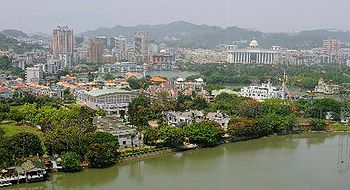
The exact foundation date of this city is not known. When Yue to the north of Fujian was annexed by Chu in 306 BC, a branch of the royal family of the defeated Yue fled Fujian and became the Minyue (闽越) tribe.
The first city wall of Fuzhou was built in 202 BC when Liu Bang, the founding emperor of the Han Dynasty, gave permission to Wuzhu (无诸), the king of Minyue, to set up his capital in Fuzhou. The city was named Ye (冶), meaning "The Beautiful". The name has changed many times, but the city has been continuously occupied since 202 BC and has never suffered major destruction by wars or natural disasters.
The Minyue was annexed by Han in 110 BC and became a part of China, and Fuzhou became Ye County. During the Jin Dynasty, West Lake, East Lake (now silted up) and numerous canals in the city were constructed (282 AD).
When the Jin Dynasty collapsed, the first wave of immigrants of the gentile class arrived in Fujian (308 AD). During the Tang Dynasty (725 AD), it started to be called Fuzhou.
More immigrants arrived from the north starting from 892 as the Tang Dynasty was collapsing. After the Tang Dynasty fell in 907, the Wang family managed to establish a kingdom called Min (909 – 945) with its capital in Fuzhou, then known as Changle. Min is still used as another name for the province of Fujian, in names of region such as minnan, and the river that runs through Fuzhou is called Min Jiang.
New city walls were built in 282 AD, 901 AD, 905 AD, and 974 AD, so the city had many layers of walls — more than the Chinese capital.
Emperor Taizong of the Song Dynasty (宋) ordered destruction of all the walls in Fuzhou in 978 AD but new walls were rebuilt later. The latest was built in 1371 AD.
During the Southern Song Dynasty, Fuzhou became more prosperous; many scholars came here to live and work. Among them were Zhu Xi (朱熹), the most celebrated Chinese philosopher after Confucius, and Xin Qiji (辛弃疾), the greatest composer of ci (a specialized form of poem). After them came Marco Polo, who transcribed the placename in Italian as Fugiu according to Mandarin Chinese.
Hualin Temple in the original Ye city, which has been declared a national heritage site, was built in 964 AD according to documentation, but was carbon-dated to the 4th or 5th century AD. It is probably the oldest existing wooden structure in China.
Between 1405 and 1433 AD, the Chinese (Ming) navy fleet, led by Zheng He, sailed from Fuzhou to the Indian Ocean seven times; on three occasions the fleet landed on the east coast of Africa. Before the last sailing, Zheng erected a stele dedicated to the goddess Tian-Fei (Matsu) near the seaport.
In the 19th century, Lin Zexu, a native of Fuzhou, led an unsuccessful attempt to resist the British fleet at Canton Bay, and Lin was exiled to the Russian border. At the end of the First Opium War, Fuzhou became one of the five Chinese treaty ports opened by the Treaty of Nanjing (signed in 1842). Lin Zexu died on November 22, 1850 at age of 66.
On November 8, 1911, revolutionaries staged an uprising in Fuzhou. After an overnight street battle, the Qing (Manchu) army surrendered. On November 22, 1933, the leaders of the 19th Army set up a short-lived Republic of China (中華共和國) in Fuzhou (compare the name to Chiang’s “Republic of China” (中華民國), which literally means “People’s State of China”); it collapsed in two months.
Around 1940, the Japanese army decided to invade Fuzhou. Surrounded by hills on 3 sides, the Japanese army quickly bombed and invaded the city. Japanese planes quickly bombed the only escape route for Chinese civilians- the bridges across the neighbouring river, leaving many civilians dangerously crossing the river on foot. The Japanese soon took the city and held it until Japan's surrender in 1945.
See also: Battle of Foochow
On December 13, 1993, a raging fire swept through a textile factory in Fuzhou and claimed the lives of 60 workers.[1]
On October 2, 2005, floodwaters from Typhoon Longwang swept away a military school, killing at least 80 paramilitary officers.[2]
Districts and counties
The administrative divisions of Fuzhou have changed frequently in history. In 1983, Fuzhou administered 5 districts and 8 counties, whose territory has not changed since then. In 1990 and 1994, Fuqing (Hók-chiăng) and Changle (Diòng-lŏ̤h) counties were promoted to county-level cities. Despite this change, the old statement of "5 districts and 8 counties" is still popular among the local people.
- Districts: Gulou (鼓楼, Gū-làu), Taijiang (台江, Dài-gĕ̤ng), Cangshan (仓山, Chŏng-săng), Mawei(马尾, Mā-muōi), Jin'an(晋安, Céng-ăng).
- County-level cities: Fuqing (福清,Hók-chiăng), Changle (长乐,Diòng-lŏ̤h).
- Counties: Minhou (闽侯,Mìng-âu), Minqing (闽清,Mìng-chiăng), Yongtai (永泰,Īng-tái), Lianjiang (连江,Lièng-gŏng), Luoyuan (罗源,Lò̤-nguòng), Pingtan (平潭,Bìng-tàng).
- Township: Guantou (琯头, Guàn-tóu)
- Village: Shandou(山兜,Shān-Dōu )
Transportation

- Airport
Now Fuzhou owns two ariports,namely: Fuzhou Changle International Airportand Fuzhou Yi Xu airport(Old airfield).The former one is its main international airport and a air-hub in the southeast China, the latter one is turned to as a PLA airbase after 1997.
- Railway
The Fuzhou rail station locates in the north of Fuzhou,which near the North Second-round road. The Strait rail station in Changshan District has been constructing from 2007,which will be completed in 2010,is a key landmark of New city develpment scheme.
- railway system
Now the main railway is "WaiFu railway",connecting eastwards through North districts from Jiangxi province,owning a subline "Fuma railway" ,which from city hub to Mawei district. Two railway have been constructing,they are "WenFu railway",connecting northwards with Wenzhou in south of Zhejiang province;another is "Fuxia railway",running southwards to Xiamen,which is desiged as a high-speed railway up to 200KM.It will be completed in early July,2009
- Seaport
In 1867 the Fuzhou seaport was the site of one of China's first major experiments with Western technology, when the Fuzhou Navy Yard was established; a shipyard and an arsenal were built under French guidance, and a naval school was opened. A naval academy was also established at the shipyard, and it became a center for the study of European languages and technical sciences. The academy, which offered courses in English, French, engineering, and navigation, produced a generation of Western-trained officers, including the famous scholar-reformer Yan Fu (1854–1921).
The yard was established as part of a program to strengthen China in the wake of the country's disastrous defeat in the trading conflict known as the second Opium War (1856–60). But most talented students continued to pursue a traditional Confucian education, and by the mid-1870s the government began to lose interest in the shipyard; it had trouble securing funds and declined in importance. Fuzhou remained essentially a commercial center and a port until World War II; it had relatively little industry. The port was occupied by the Japanese during 1940–45.
Since 1949, Fuzhou has grown considerably; its communications have been improved by the clearing of the Min River for navigation by medium-sized craft upstream to Nanping. In 1956 the railway linking Fuzhou with the interior of the province and with the main Chinese railway system was opened. The port, too, has been improved; Fuzhou itself is no longer accessible to seagoing ships, but Luoxingta anchorage and another outer harbor at Guantou on the coast of the East China Sea have been modernized and improved. The chief exports are timber, fruits, paper, and foodstuffs.
Economy
Industry is supplied with power by a grid running from the Gutian hydroelectric scheme in the mountains to the northwest. The city is a center for industrial chemicals and has food-processing, timber-working, engineering, papermaking, printing, and textile industries. A small iron and steel plant was built in 1958. In 1984 Fuzhou was designated one of China's "open" cities in the new open-door policy inviting foreign investments. Handicrafts remain important in the rural areas, and the city is famous for its lacquer and wood products.
Its GDP was ¥29,318 (ca. US$3,850) per capita in 2007, ranked no. 21 among 659 Chinese cities.
Culture
Fuzhou, also known as the City of Banyan after the many Banyan trees that dot the city landscape, may not be as rich in history as some other ancient Chinese cities but still boasts a fair number of historical sights.
People in Fuzhou mostly speak Min Dong (simplified Chinese: 闽东语; traditional Chinese: 閩東語; pinyin: Mǐndōngyǔ; Foochow Romanized: Mìng-dĕ̤ng-ngṳ̄) and Fuzhou dialect is consider the standard form of Min Dong language.
- Fuzhou dialect
Famous sightseeing spots

- Sanfang Qixiang (三坊七巷) (a cluster of ancient resident buildings dated from late Jin Dynasty)
- West Lake (福州西湖) (an artificial landscape style lake built in 282 AD)
- Hualin Temple (华林寺) (Built in 964 AD,Song dynasty)
- Dizang Temple (The temple of sacrificing guardian of the earth,founded in 527 AD)
- Xichan Temple (西禅寺) (founded in 867 AD)
- Wu Ta (乌塔) (Black Pagoda) (originally built in 799 AD, rebuilt in 936 AD)
- Bai Ta (白塔) (White Pagoda) (originally built in 905 AD, 67 m in height, collapsed in 1534 AD, rebuilt in 1548 AD, 41 m in height)
- Yongquan Temple (涌泉寺) (founded in 915 AD)
- Gu Shan (鼓山) (Drum Mountain)
- Fuzhou National Forest Park (福州国家森林公园)


Local Parks and Museum
- Xihu Museum (西湖博物馆)
- Wulongjiang Shidi Park (乌龙江湿地公园)(A wet Land Park, however the park is on the verge of completely gone due to ineffective environment protection and land constructions.)
- senlin Park (森林公园)

Colleges and universities
- Fujian Normal University (福建师范大学) (founded in 1907)
- Fuzhou University (福州大学)
- Fujian Agriculture and Forestry University (福建农林大学)
- Fujian Medical University (福建医科大学)
- Fujian College of Traditional Chinese Medicine (福建中医学院)
- Minjiang University (闽江学院)
- Fujian University of Technology (福建工程学院)
Note: Institutions without full-time bachelor programs are not listed.
Sister cities
 Nagasaki, Japan
Nagasaki, Japan Naha, Japan
Naha, Japan Gunsan, South Korea
Gunsan, South Korea George, South Africa
George, South Africa Koszalin,Poland
Koszalin,Poland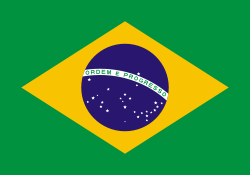 Campinas, Brazil
Campinas, Brazil Sibu, Sarawak, Malaysia
Sibu, Sarawak, Malaysia Ayer Tawar, Sitiawan, Perak, Malaysia
Ayer Tawar, Sitiawan, Perak, Malaysia
See also
- Min Dong language
- Fuzhou dialect
- List of cities in the People's Republic of China by population
References
External links
|
||||||||||||||||||
|
||||||||||||||||||||||||
